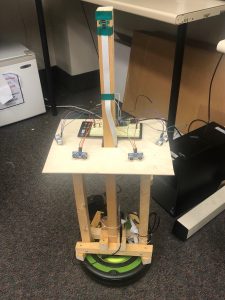Arushi – This week I didn’t get a chance to work on Cart-i B too much, which is why I spent more time last week. I worked with Shreyas to change the pid to based off of the radius of the target rather than the area to prevent it from jerking as much when we step close to it/when it would have to move backwards. This really smoothed out its movements in forward and backwards motions. Additionally, we worked on further refining the aisle turn code. Throughout this weekend, I plan on going in with Shreyas to further test and refine the obstacle detection/path planning.
Pallavi – This week I was mainly working with Shreyas to fine tune the obstacle detection now that it is integrated with the entire Carti-B structure. One major thing we changed was the distance threshold we were going to use to fire an interrupt and indicate an obstacle. We realized our threshold was too large, so it was actually detecting the human it was tracking as an obstacle and not moving. Another change made to our design was what information we are actually sending over from the arduino to the raspberry pi. Before we were sending the actual distances for all four of our sensors. We realized, however, our path planning algorithm did not need the actual distances and just what sensor has an obstacle violating the threshold. We achieve this by creating a 4-bit value initialized to 0000. When any sensor violates the obstacle threshold, we check each sensor and if it has an obstacle in the violation range, we set that value to be 1. So, if we had a violation in sensors 1 and 3, we would send 1010. This is to remove any extraneous information that is ultimately not used in our final code.
Next week, I will be out of town for Thanksgiving so I will not be able to work on Carti-B. Happy Thanksgiving!!
Shreyas – This last week I worked with Arushi re-configuring the PID to use the radius instead of the area. This made moving backwards a lot smoother. I also worked with Pallavi to change the format data is sent from the arduino to the pi. I got the interrupt handler to work properly so that it properly sets a global flag of whether or not an obstacle exists. In the loop logic based on the flag, the robot will either move normally, stop, or execute a re-route path to get around the obstacle. After my basic testing Thursday, it works pretty well but more testing needs to be done to tune how much the robot turns to avoid the obstacle and how much the robot moves ahead before looking for the human again. We also decided how we’re going to secure the basket to the robot and what kind of basket to get. We also decided we’re going to buy a cheap medium size black jacket and just tape the green circle and red circles on. This weekend Arushi and I will work on finalizing the obstacle detection protocol.

